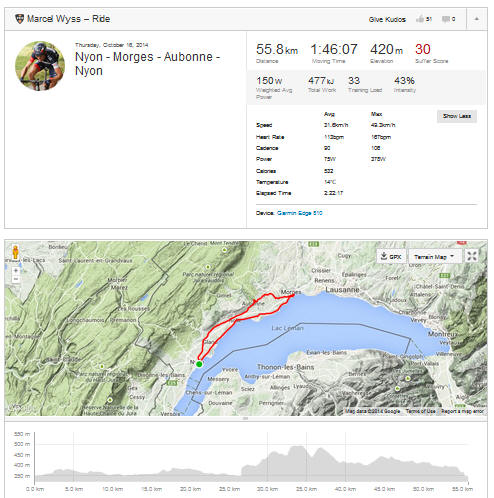Training Your Heart...
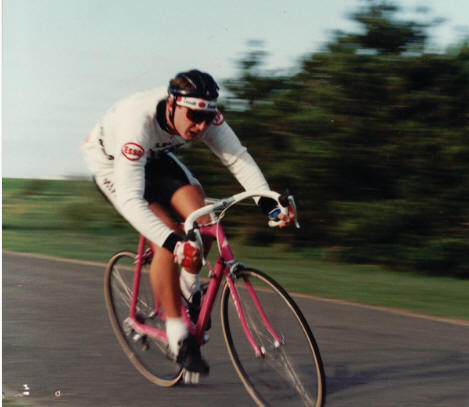
me, 1986, going fast (look at the blurred trees & sweatband) on a pink bike!
Show me the boy and I'll show you the man, someone more famous than me once said. Well, show me the heart and I'll show you the athlete, I just said to myself...
A Brief History of Time
I started "race" riding a bike when I came to Jersey in 1985. In those days
cycling clubs had an
ordered and strictly adhered hierarchy that was steeped in tradition.
New riders stayed at the back and were only allowed to progress to inside the pack, and up the line, when they'd earned their place by not doing anything stupid. You looked and you learned.
If you didn't learn, you were told; sometimes not too delicately. We didn't have political correctness in them days.
After your first year, you were allowed near the front. Riding in a pack, especially at the front has many responsibilities and obligations, least of which is setting the right pace. You're not there to impress anyone, because you won't; your most important job, in the winter, is to keep the pace steady, safe, consistent and low.
Most "unstructured" (read uncontrolled) group rides have their slow rides too fast and their fast rides too slow. It's always, "lets go as fast as we can for as long as we can".
I believe the main reason for this is the huge influx of new riders over the last ten years or so that didn't, "go through the system". These are super fit people that never learned to ride slow. So they don't, they "race" all year round. They are missing such a trick.
Racing is for the summer, winter is for training. Races are held in the summer but won in the winter. Summer racing is for stressing the heart; winter riding is for training the heart.
Here's how we do it, and why we ride slow to go fast.
Once you have read this hopefully it will all make sense. So please persevere with this longish factsheet. Because this will make you a much faster rider when the time is right. In the summer.
Before We Start
All training is good, no training is bad. Any activity will
increase your fitness levels and most riders believe all forms of training
are
equally good; but some forms of training are more equal than others.
The fundamental principle of training (if it is to prove beneficial, sustainable and successful) is that it has to equally stress the body's various physiological systems to increase their performance, whilst maintaining balance and harmony.
Concentrate on doing the right things, in the right order, at the right time and the magic "just happens". No use having five litre lungs, if you only have three litre legs.
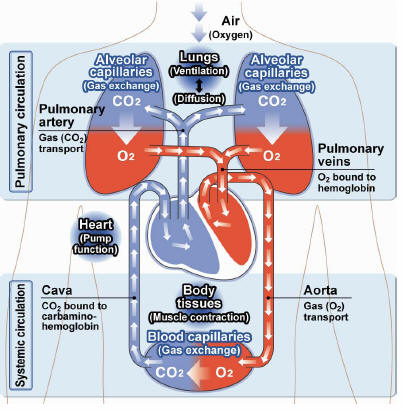
You do not want any performance pinch points between getting the air from outside your body, to inside your lungs, blood, heart, legs and back out to the outside air again. So where do we start...?
The Heart of the Matter
I've said this before, and I'll say it again (probably too many
times); cycling is all about oxygen delivery. First,
foremost, last and everything else in between.
How quickly you go depends primarily on how much oxygen you can get to your muscles, and how quickly you can get it there. Demand will always exceed supply; always.
Your number one winter objective as a racing cyclist or endurance athlete, is to create as much oxygen supply as you legitimately can, with the aim of making yourself as efficient and effective as possible for the summer.
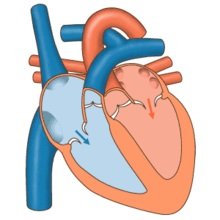 As discussed previously, there are many factors that influence
oxygen delivery. Most are genetic.
As discussed previously, there are many factors that influence
oxygen delivery. Most are genetic.
The main players are, the heart, the lungs, the bloodstream, mitochondria and muscle capillarization.
One of the biggest contributors is the lungs, but you can't really mess about with them. However, there are other factors you can quite easily influence, adapt, train and change.
And strangely enough, luckily for this factsheet, your heart is
one of them.
Your heart is a muscle that can, and will, respond to training. Correct, targetted, specific training will be far more beneficial than "just training".
Perversely, and counter-intuitively, it will respond in a more conducive way to making you a better endurance athlete by riding slower.
Rhythm of the BeatYou've probably been mesmerised by the beating heart in the diagram above. So here's what's happening and why it's important to you. I'm not going to get too technical, so for all our doctors friends out there (I know there are many) please humour me at this basic level.
Your heart is effectively a two-stage, four-valve pump. Bringing old stuff in and sending new stuff out. Although working in harmony, the two sides are mutually exclusive.
At the top of the heart are the blood collection chambers, the right and left atria. At the bottom of the same heart, are the distribution chambers, the right and left ventricles. The two sides should, and will, never meet.
Although the functions of each side of the heart are different, they have a common beat, which is where our compromises begin.
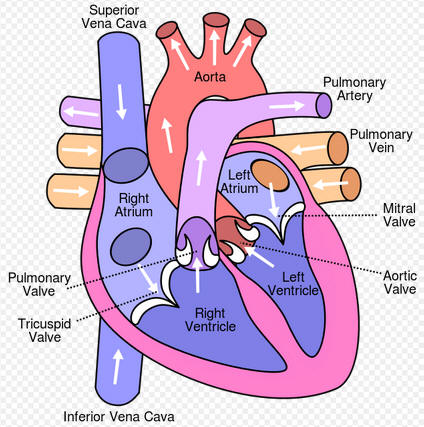
"Used blood" returns from around the upper body through the Superior Vena Cava, while it returns from the lower body via the Inferior Vena Cava. It all gets deposited in to your Right Atrium (top left).
The "dirty blood" gathers and pools in the upper chamber until it's squeezed by the heart beat in to the Right Ventricle below it.
When the heart next contracts, blood is forced out of the right ventricle through the Pulmonary Artery to head off for the lungs where it's bathed in oxygen and cleansed.
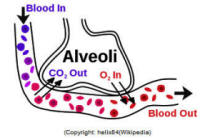 The
blood goes in to the lungs "blue", dropping off carbon dioxide to be
exhaled, then
comes out "red" having picked up inhaled oxygen from the alveoli.
The
blood goes in to the lungs "blue", dropping off carbon dioxide to be
exhaled, then
comes out "red" having picked up inhaled oxygen from the alveoli.
The oxygen-enriched blood returns to the heart via the Pulmonary Veins which are the "two pairs of horizontal sticky-out bits" each side of the heart.
This "power blood" now pools in the upper Left Atrium before it's fed in to the chamber below it. Which is the Left Ventricle.
When the heart contracts again, the pressure from the left ventricle opens the three pipes of the Aortic Valve to send the oxygen dense blood out around the body to all the places it's needed.
There you have it. Two distinct, mirror-image sections of the heart; one side for "used blood" from the body, on it's way to the lungs. The other side for "fresh blood" from the lungs on it's way to the body.
Now you know what it does and how, here's why you should treat this little power pump gently during the winter. And how you can best tune it for maximum efficiency to help you win in the summer...
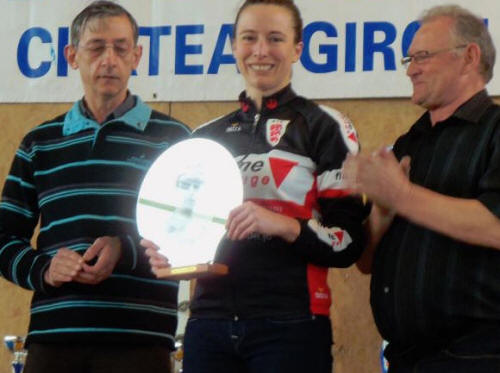
One of these riders is a Milan San Remo winner,
the other a race champion and the third? Looks like he's a coach...
Slowly Become a Champion
As you've seen from above, the heart has four chambers that pump
blood from one to the other and around the body.
Let's take just one, the one that sends the oxygen rich blood to our muscles, the left ventricle. This chamber can be increased significantly with the right training.
That's because the right ventricle only has to pump against pulmonary pressure (the lung system) whereas the left ventricle has to pump against "system-wide body pressure". It has to work harder to shift the same volume of blood.
So lets see how it operates on a step by step, beat by beat, basis...
One of the compromises of the heart is that it has four independent chambers that are controlled by a common heart beat.
When the heart beats, ALL the chambers will empty, no matter what the status and volume of their capacity and contents.
The chambers are not uniform in size so there could be more "relative" blood in one chamber than there is in another when it's asked to "move on". A chamber that's 90% full could be depositing blood in to the next chamber to fill it to 80% capacity.
 If your heart is beating quickly, obviously the blood flows quickly.
A quick heart beat means the chamber (in this case the left
ventricle) will not have time to fill fully with oxygen-rich blood
before the mixture is required to disappear off to the bike-powering muscles.
If your heart is beating quickly, obviously the blood flows quickly.
A quick heart beat means the chamber (in this case the left
ventricle) will not have time to fill fully with oxygen-rich blood
before the mixture is required to disappear off to the bike-powering muscles.
Here's your first issue to sort out in the "dark months". If you are going to spend three months riding around at weekends in a cold, wet, damp winter, why aren't you making best use of your saddle time?
Why are you sending, with every (quick) heart beat, a compromised, half-arsed packet of blood to your muscles, from an underperforming and under capacity, inefficient heart? Or engine as we can assume it to be.
Every year your car goes in to the garage for a professional engine service. How about paying the same respect to your own personal power plant? Even better, there's no cost for doing so!
When your heart beats slower the valves inside the heart will stay open for longer. The longer they are open the more blood will flow through them in to the chamber.
To explain why this is important, we're going to do a little experiment. Here's the good bit; sexy science...
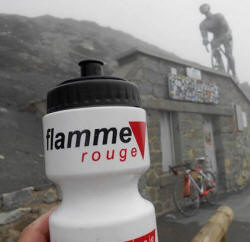 Before
you go for your next winter ride, fill your water bottle (with plain
water) to the brim; the very, very, top.
Before
you go for your next winter ride, fill your water bottle (with plain
water) to the brim; the very, very, top.
Now go outside, we don't want any indoor embarrassments. Especially if you have a new kitchen ~ EFR in-house joke!
Hold the bottle upright (as so...) and squeeze the water out of it. noting how high the water goes.
Next, take the lid off, empty out half the contents, put the lid back on and squeeze again.
That concludes our experiment.
What Happened There?
You will notice that the full to the brim
bottle, squirted a huge trough of water in to the sky. On a
good day you can get to see a rainbow.
The half empty bottle (no matter how hard you tried) probably just whistled at you, as a puff of air was lost in the ether. At best a spurt jumped an inch out of the nozzle.
Some of our more sensitive and astute riders (probably climbers), will notice how much easier it was to squeeze the half empty bottle.
So our experiment seems to show that squeezing a fully-full bottle, although it's harder, gives you far more oomph than a half empty one.
Remember my constant mantra (our first tautology of the day) about cycling being counter-intuitive? Well here's a classic example...
When you ride slower, the heart beats slower, and obviously the valves are open for longer; the chambers fill more fully, meaning the heart has to squeeze harder to empty the extra volume from the chamber.
Understanding that one sentence, means you are well on the way to transforming your coming season.
By clearing a full, left ventricle, not only does your heart get stronger with every beat (it's a muscle remember it will respond to stimulus) you are also sending larger volumes of oxygen rich blood to your muscles with every single contraction!
Which is important when you're competing in an endurance event. Riding the Ventoux Masters, my heart beated (?) 103,125 times during the five ascents. Which, by any stretch of the imagination, is a lot.
So you see, a tiny improvement in cardiac capacity gleaned during the winter, can have huge rewards come the summer.
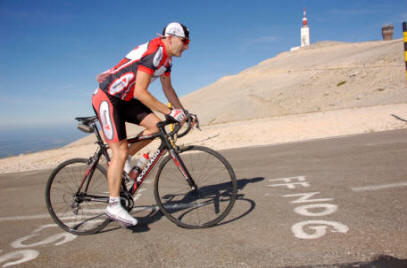
Ventoux Masters ~ run three of five
Less Haste More Speed
Cycling, at whatever level you choose to partake, is an oxygen driven sport. To
recap;
oxygen rich blood is pumped by the heart to your muscles. The oxygen gets in
the blood via the lungs.
Blood goes through the heart, the lungs and the muscles. That makes all these things equally important to your development. Pay equal attention to all of them all of the time.
The efficiency of your heart and lungs will determine how good a cyclist you will be. The efficiency of your heart is determined by the volume of the chambers within it and the strength of the muscle around it.
Your lungs are genetically set, so changing them is a little difficult. But you can, through breathing techniques and controlling your heart rate, dramatically increase the oxygen transfer that happens within them.
Also, you can increase your plasma volume, heart chamber volume and heart contraction strength with the correct training.
All of these things contribute to your cardio-capacity. Cardio capacity is directly linked to oxygen carrying capacity, and it's that, that wins races.
Conceptually, slowing the blood flow down is also important.
When you are racing, or in a sportive, you don't go blasting through the feed stations at full gas hoping to pick up a bottle. You may get lucky and get something, but not everything you want or need.
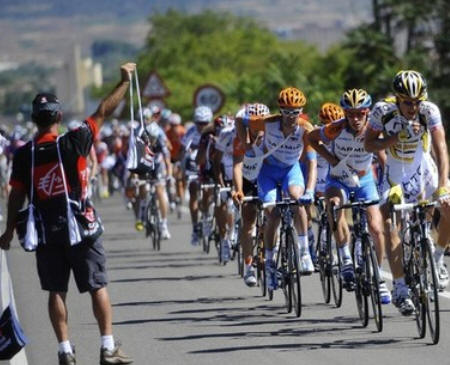
Imagine your blood screaming through the body, like a full-gas peloton, trying to pick up oxygen from the (feed-station) lungs. The less time the blood spends there, the less oxygen it can pick up.
 Having "rushed" past the
lung's 300 million alveoli, it has to blast through the muscles, trying to drop off
what little oxygen is has, while exchanging it for a bit
of lactate and carbon dioxide as it passes through.
Having "rushed" past the
lung's 300 million alveoli, it has to blast through the muscles, trying to drop off
what little oxygen is has, while exchanging it for a bit
of lactate and carbon dioxide as it passes through.
Before belting back to the lungs to try and purge your systems of all the debilitating "stuff" that, ironically, you are producing due to the lack of available oxygen in your cardio-vascular system.
Thereby creating the most vicious of race-ruining circles.
Wouldn't it be a little bit better if this was more controlled?
Why not ride slow, drop the heart rate, decrease the blood flow, maximise oxygen uptake (and lactate clearance), increase enzyme and metabolic activity, raise cardio efficiency and effectiveness, and spare glycogen, to build yourself up rather than tear yourself down.
Are there any downsides to this method of riding? No, only mental ones. The difficulty most people have is keeping their discipline. They see others riding fast and wonder, "should I be doing that"? A lot crack, and begin riding too fast, too soon. Riding slow is a constant mind game.
Once you are "all based up", you can take these increases in efficiency and effectiveness and apply them to your Pre-Comp period and beyond.
How the Pro's Ride
Again, I'm in debt to our Franco/Swiss rider extraordinaire,
and Team IAM aficionado Ally Bainton for his help.
He sent me this Strava file from his close neighbour at Lac Leman, IAM pro,
Marcel
Wyss...
55 kms ~ 1:46 h:mm ~ 43% intensity ~ Suffer Score 30 ~ 90 rpm avg
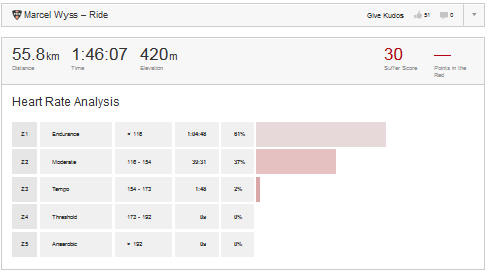
98% of the ride at or below Zone 2 heart rate
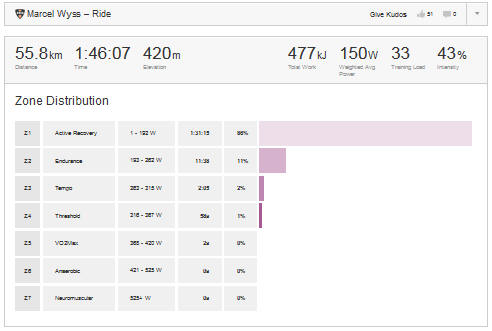
97% of the ride at or below Zone 2 power
To be honest, there's nothing more to say. The above diagrams say it all.
Slacktober to Slowvember
Riding slowly, keeping your heart rate under control, with a
steady-state, aerobic, endurance ride, will increase heart
chamber volume, heart muscle mass and your overall cardio efficiency.
As does
pregnancy, but that's currently outside the remit of this factsheet!
A "trained heart" can have a wall thickness (the pink bit in the diagram above) of 1.3 cms, compared to 1.1 cms for a "normal" adult heart. Just like any other increase in muscle size, this makes the heart stronger and more powerful.
An excellent indication of the increase in heart size for a trained athlete, is through the measurement of resting heart rate. A low heart rate (bradycardia) is a good indication of a "large chamber".
Measure your heart rate now, (first thing each morning) and take the average over three consecutive "low activity" days. Monitor it monthly through your base period and watch it fall.
At rest, people generally require around five litres of blood per minute. An untrained person's heart will beat at up to 70 bpm to deliver this. A well trained person will be below 50 bpm.
At 180 bpm, an unfit person will shift 12 litres of blood per minute. A well trained person may shift up to 22 litres of blood in that same minute.
Remember, blood equals oxygen. More blood, more oxygen, more speed. If you can increase your cardio capacity by just 1%, how good would that be? Very, is the answer!
Riding anaerobically (fast) increases the muscle wall thickness of the heart, but not the chamber volume. A thick walled muscle will beat stronger; but it will shift less blood if the chamber inside the heart is of restricted size.
Riding around at warp factor sprint all winter will make you feel good (for a bit) and will increase the thickness of the muscle wall. Which can actually restrict the size and potential volume of the chamber at a later date.
As an other experiment; imagine blowing up a balloon. Now imagine blowing up a water bottle. It's much harder to develop the chambers of a thick walled heart.
Which is why it's important to "de-train" in the off-season Slacktober.
To compare notes with IAM Pro Marcel, here's some info from our resident, potential, IAM stagiare Craig Grant and our equipe flamme rouge Slowvember ride from November 1st 2014...
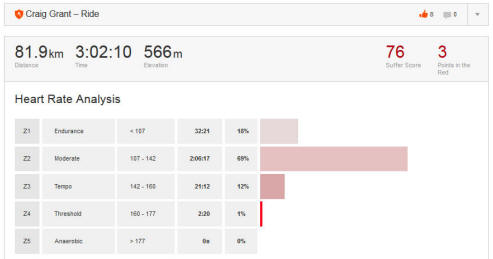
Craig Grant, three hours riding, at 27 kph, averaging 123 bpm, maxing at 166 bpm, because we had two climbs we had to traverse.
Most of this ride was Zone Two or below, 87% ridden below 142 bpm. During the ride, Craig's heart beat 22,140 times. 19,262 of which, were in the "chamber development" zone.
Imagine if they were Bicep Curls; how strong would his arms be?
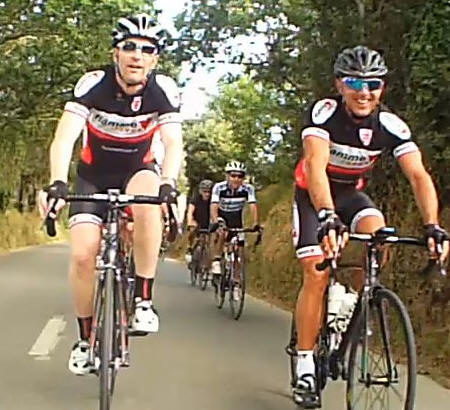
Craig Grant & Richard Mayne ~ smelling the flowers...
If all you do is steady state riding (Iron Man athletes) then you'll build a huge chamber (relatively speaking), be an aerobic monster, but will get dropped with the first attack of the race.
If you're a Club Run Champion, then you will be forever burning glycogen (and producing lactate), as you will not have trained your body to burn fat. Your heart wall will increase in thickness, hampering future chamber development and sooner or later, you will implode.
The easiest of sessions will appear much harder to you than they do to anyone else. Time to back right off or sooner or later, you will fatigue.
Off the front in February, out the back in March, on the couch in April. Take two weeks rest while you can.
The Message
Your heart, lungs and blood are the unseen power houses of your
cycling. Having big muscles might look good, but look at
Froome's and Contador's legs; they are like our arms!
Become a better athlete, not a bitter one. Get two months of aerobic conditioning in your legs, move on to the strength and stamina work, then bang in the speed and high intensity stuff as you start the season.
The heart is a muscle, it responds to training. At just 60 bpm, it will beat 30 million times a year. In a lifetime it will contract over 2 billion times, mostly, without a flicker.
A 3 hour ride, can give you over 22,000 heart training beats, imagine doing that many "push ups" with your arms and how good they would get after a month!
In a nutshell, the main message is, observe Rule # 1 of the Rebels Charter, leave your ego at home. Village Policeman pace in Slacktober and Slowvember. Just smell the flowers and take your heart for a walk.
Because in eight weeks time, we do the Climbageddons. Now that will give your heart rate a battering!
It's all about sustainable progression. Workout, don't burnout. Because a burnt-out athlete, is a sad athlete. And there's nothing sadder than a sad athlete that's wasted a sad winter but hasn't realised how sad it is until it's too sadding late.
Laters my aerobic chums. Laters...

